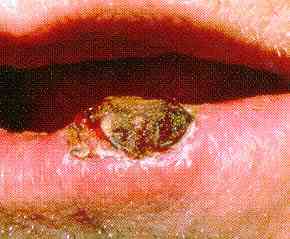Squamous
cell carcinoma of the lip: the role of electron treatment.
Sykes Clin Oncol (R Coll Radiol)
1996;8(6):384. After skin cancer, squamous cell carcinoma (SCC) of the lip is the most
common cancer of the head and neck. It can be treated in a variety of ways, including both
surgery and radiotherapy. Many centres have reported excellent cure and local control
rates for their chosen treatment method. Electron beam
treatment is recognized as a method of treatment and has theoretical advantages related to
its depth-dose characteristics. We report a retrospective study of the treatment with
electrons of 26 patients with Stage T1-2 SCCs of the lip. With a median follow-up period
of 31 months (range 1.5-60) 100% local control was obtained,
although two patients required surgical salvage, one for a geographical miss. Electron
treatment for T1-2 SCC of the lip is an effective, well tolerated treatment for these
patients, many of whom are elderly and frail.
Results of radiotherapy for
squamous cell carcinoma of the vermilion border of the lower lip. A retrospective analysis
of 108 patients.
de Visscher
Radiother Oncol 1996
Apr;39(1):9-14 The authors analyzed the clinical history, tumor histology and stage, and
outcome of a group of 108 patients with squamous cell carcinoma (SCC) of the vermilion
border of the lower lip who underwent radiation therapy in
the period between 1980 and 1992. The total tumor dose varied from 48 Gy to 70 Gy,
depending on the radiation modality (orthovoltage, electrons, photontherapy and iridium
implants). Local control was achieved in 88 out of 89 (98.9%)
patients with T1, in 13 out of 17 (76.5%) patients with T2 and in both patients
with T3 tumors. Local treatment failures (4.6%) were cured by salvage surgery. During
follow-up, regional lymph node metastases at level I (submental and submandibular groups)
occurred in 11 out of 89 (12.4%) patients with stage I and in I out of 15 (6.7%) patients
with stage II tumors. After salvage treatment of local failures and regional metastases
the total group of patients with stage I and II SCCs of the vermilion border of the lower
lip showed a definitive control rate of 98.1%.
Squamous cell carcinoma
of the lip: a retrospective review of the Peter MacCallum Cancer Institute experience
1979-88.
McCombe D, MacGill K, Ainslie J, Beresford J, Matthews J.
Aust N Z J Surg
2000 May;70(5):358-61
Peter MacCallum Cancer Institute, Melbourne, Victoria, Australia.
BACKGROUND: Squamous cell carcinoma (SCC) of the lower lip is a common malignancy in
Australia. Surgical excision and/or radiotherapy are used in treatment, and are regarded
as equally effective. METHODS: A retrospective review of 323 patients treated at the Peter
MacCallum Cancer Institute with either surgical excision and/or radiotherapy, evaluated
disease recurrence, cause-specific mortality, and the incidence of metachronous lesions.
RESULTS: Recurrence-free survival at 10 years was estimated to be
92.5%, and cause-specific survival at 10 years was estimated to be 98.0%. Equivalent rates of local control were obtained with surgery and
radiotherapy. Recurrence was related to tumour stage and differentiation. A
high incidence of metachronous lesions was noted, 25 patients had a lesion prior to
presentation and 33 patients developed second lip lesions during the study period.
CONCLUSIONS: Squamous cell carcinoma of the lower lip is well treated with surgery or
radiotherapy. The preferred treatment for most patients with SCC of the lower lip in the
Australian population is surgical excision. This study has shown a significant incidence
of metachronous lip neoplasia, except in those patients whose whole lip had been
resurfaced. |






